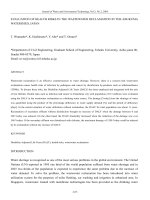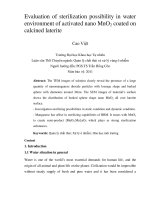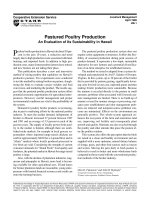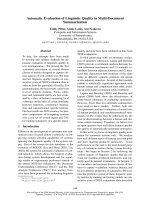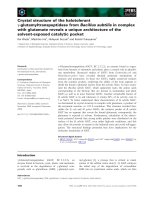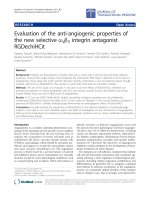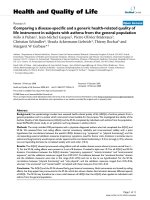Evaluation of the anti diabetic properties of averrhoa bilimbi in animals with experimental diabetes mellitus
Bạn đang xem bản rút gọn của tài liệu. Xem và tải ngay bản đầy đủ của tài liệu tại đây (690.46 KB, 188 trang )
EVALUATION OF THE ANTI-DIABETIC PROPERTIES
OF AVERRHOA BILIMBI IN ANIMALS WITH EXPERIMENTAL
DIABETES MELLITUS
PETER NATESAN PUSHPARAJ
NATIONAL UNIVERSITY OF SINGAPORE
2004
EVALUATION OF THE ANTI-DIABETIC PROPERTIES
OF AVERRHOA BILIMBI IN ANIMALS WITH EXPERIMENTAL
DIABETES MELLITUS
PETER NATESAN PUSHPARAJ
M.Sc., BIOCHEMISTRY (St.Joseph’s College, Trichy, India)
M.Sc., ZOOLOGY (Annamalai University, India)
B.Ed., (Annamalai University, India)
A THESIS SUBMITTED
FOR THE DEGREE OF DOCTOR OF PHILOSOPHY
DEPARTMENT OF BIOCHEMISTRY
NATIONAL UNIVERSITY OF SINGAPORE
2004
i
ACKNOWLEDGEMENTS
I am deeply indebted to my supervisors; Assoc. Prof. Tan Chee Hong and Assoc. Prof.
Benny Kwong Huat Tan, for their invaluable guidance, expert advice and constant
encouragement that made my research experiences in the National University of
Singapore (NUS) an invaluable wealth for my future. Their scientific acumen and sharp
observations have helped me accomplish tasks that would otherwise have been difficult to
achieve.
I wish to express my deepest thanks and appreciation to Principal Laboratory Officers,
Ms. Ng Foong Har of the Department of Biochemistry and Ms. Annie Hsu, of the
Department of Pharmacology and Ms. Boon Yoke Yin, Laboratory Officer, Department of
Biochemistry, for their invaluable help throughout my PhD work. Without their effective
support and expertise, it would not have been possible for my experiments to proceed
smoothly. My sincere thanks are due to the office staff of the Department of Biochemistry
and Pharmacology for their kindness and timely help. I am grateful to the former Head,
Prof. Sit Kim Ping and the present Head, Prof. Barry Halliwell, and Deputy Head Prof.
Jeyaseelan of the Department of Biochemistry for facilitating requests and approvals
during the period of my study. I would like to thank NUS for offering me a research
scholarship.
My sincere thanks to Dr. Mohd Shirhan for his timely help, especially, during the last
phase of the experiments. I also thank the postgraduate students in the Department of
Biochemistry and Pharmacology for all the joy they brought to my life during these years.
ii
I thank my family for their invaluable support throughout my PhD work. I am indebted
to my brother Jude for his sacrifice, patience and commitment to take care of my
Grandparents and Parents when I was away for pursuing my PhD in Singapore. I really
appreciate my wife Jude Aarthi for her patience and understanding when I was preparing
the final draft of my thesis. I thank the Lord for giving me good health and strength to
finish this PhD dissertation for without his grace nothing is possible.
iii
TABLE OF CONTENTS
Page
ACKNOWLEDGEMENTS…………………………………………………………………… i
TABLE OF CONTENTS……………………………………………………………………… iii
LIST OF FIGURES…………………………………………………………………………… ix
LIST OF TABLES……………………………………………………………………………. xiii
LIST OF ABBREVIATIONS…………………………………………………………………. xiv
LIST OF PUBLICATIONS…………………………………………………………………… xviii
SUMMARY…………………………………………………………………………………… xxi
CHAPTER 1: GENERAL INTRODUCTION
1
Section 1:
Diabetes mellitus and blood glucose homeostasis……………………………….
2
1.1
Diabetes mellitus and its diagnosis………………………………………………… 2
1.2
The classification of diabetes mellitus…………………………………………… 3
1.3
Incidence and epidemiology ………………………………………………………. 4
1.4
Regulation of glucose metabolism by insulin and pathophysiology of diabetes… 5
1.5
Free radicals and the complications of diabetes…………………………………… 9
1.6
Animal models of diabetes and prevention of diabetes……………………………. 10
1.6.1
Chemically-induced diabetes……………………………………………. 10
1.6.2
Diabesity-prone C57BL/6J mice………………………………………… 14
1.7
Oral hypoglycemic agents…………………………………………………………. 14
1.8
Botanical medicines……………………………………………………………… 16
1.9
Averrhoa bilimbi Linn……………………………………………………………… 20
1.9.1
Chemical constituents of A.bilimbi 20
iv
1.9.2
Ethnopharmacological properties of A.bilimbi…………………………
20
1.10 Aims of the thesis……………………………………………………… 22
CHAPTER 2: MATERIALS & METHODS
23
Section 1: Materials………………………………………………………………………
24
1.1
Chemicals and reagents………………………………………………………. 24
1.2
Kits…………………………………………………………………………… 24
1.3
Facilities……………………………………………………………………… 25
1.4
Animals……………………………………………………………………… 27
Section 2: Methods……………………………………………………………………….
27
2.1
Preparation and partitioning of plant extract…………………………………
27
2.1.1
Preparation ……………………………………………………………………. 27
2.1.2
Partitioning …………………………………………………………………… 29
2.2
Streptozotocin (STZ)–induced diabetic rats…………………………………… 29
2.3
High fat diet (HFD)-fed-STZ-induced diabetic rats…………………………… 31
2.4
STZ-induced diabetic C57BL/6J mice………………………………………… 31
2.5
HFD-induced diabetic C57BL/6J mice……………………………………… 31
2.6
Determination of blood glucose by the glucose assay kit…………………… 32
2.7 Determination of total cholesterol (TC) by the Cholesterol (TG) reagent kit… 32
2.8
Determination of serum high density lipoprotein cholesterol (HDL-C) by the
HDL-cholesterol kit (CHOD-PAP method)…………………………………… 33
2.9
Determination of serum triglycerides by the Peridochrom® Triglyceride (TC)
reagent………………………………………………………………………… 33
2.10
Determination of low density lipoprotein cholesterol (LDL-C)…………… 34
2.11
Determination of anti-atherogenic index (AAI)………………………………. 34
v
2.12
Serum insulin assay by ELISA kit…………………………………………….
34
2.13
Serum leptin assay by ELISA kit……………………………………………… 35
2.14
Pancreatic insulin assay ………………………………………………………. 35
2.15
Estimation of liver glucose-6-phosphatase (Glc-6-Pase) activity…………… 36
2.16
Liver glycogen assay………………………………………………………… 37
2.17
Measurement of malonaldehyde (MDA) levels in liver, kidney and pancreas
by the thiobarbituric acid (TBA) method……………………………………… 37
2.18
Protein determination………………………………………………………….
38
2.18.1 Lowry’s method……………………………………………………… 38
2.18.2 Bradford’s method…………………………………………………… 39
2.19
Determination microsomal cytochrome P
450
content…………………………. 39
2.19.1 Preparation of liver microsomes……………………………………… 39
2.19.2 Assay of liver microsomal cytochrome P
450
content………………… 40
2.20
High performance liquid chromatography……………………………………. 40
2.21
Metal analysis by atomic absorption spectrophotometer……………………… 41
2.22
Statistical analysis……………………………………………………………
42
CHAPTER 3: RESULTS AND DISCUSSION OF SIX EXPERIMENTS
43
Experiment 1:
Effects of A.bilimbi leaf extract on blood glucose and lipids in STZ-diabetic
rats…………………………………………………………………………… 44
1.1
Aims…………………………………………………………………………. 44
1.2
Experimental procedure…………………………………………………… 44
1.2.1 The OGTT in normal and STZ-diabetic SD rats……………………… 44
1.2.2 Repeated administration of the ABe in STZ diabetic SD rats…………. 45
vi
1.3
Results and discussion……………………………………………………… 45
1.3.1 Dose response effect of ABe on glucose tolerance in normal and STZ-
diabetic rats…………………………………………………………………
45
1.3.2 Effect of 2-week administration of ABe (125 mg/kg) and metformin
on STZ-diabetic rats blood glucose and lipids in STZ-diabetic rats………… 48
Experiment 2:
Evaluation of the anti-diabetic effects of semi-purified fractions of ABe in a
rat model of type 1 diabetes………………………………………………….
58
2.1
Aims………………………………………………………………………… 58
2.2
Experimental procedure…………………………………………………… 58
2.2.1 The OGTT in STZ-diabetic rats using the semi-purified fractions of
ABe………………………………………………………………………… 58
2.2.2 Twice daily oral administration of AF (125 mg/kg) and BuF (125
mg/kg) for two weeks in STZ-diabetic rats………………………………… 60
2.3
Results and discussion……………………………………………………… 60
Experiment 3:
Studies on the pancreatic β-cell protective effects of ABe, AF and BuF
against STZ in SD rats……………………………………………………….
73
3.1 Aims…………………………………………………………………………
73
3.2
Experimental procedure…………………………………………………… 73
3.2.1 Pancreatic β-cell protective study with ABe…………………………
73
3.2.2 Studies on the pancreatic β-cell protective effect of AF and BuF……
73
3.3
Results and discussion……………………………………………………… 75
Experiment 4:
Evaluation of the anti-diabetic effects of AF and BuF in a rat model of type
2 diabetes ……………………………………………………………………. 92
4.1
Aims…………………………………………………………………………. 92
4.2
Experimental procedure…………………………………………………… 92
4.2.1 Induction of type 2 diabetes mellitus in SD rats……………………… 92
vii
4.2.2 The OGTT in HFD-STZ – diabetic SD rats treated with semi-purified
fractions of ABe……………………………………………………………
92
4.2.3 Twice daily administration of AF and BuF in HFD-STZ-diabetic SD
rats……………………………………………………………………………
92
4.3
Results and discussion……………………………………………………… 95
Experiment 5:
Identification of bioactive principle (s) in ABe, AF and BuF………………
113
5.1
Aims…………………………………………………………………………. 113
5.2
Experimental procedure…………………………………………………… 113
5.2.1 RP-HPLC of ABe, AF and BuF ………………………………………. 113
5.2.2 AAS of ABe, AF and BuF…………………………………………… 113
5.3
Results and discussion……………………………………………………… 115
Experiment 6:
Evaluation of the synergistic interaction of magnesium and nicotinic acid on
glucose tolerance in animals with experimental diabetes mellitus………… 119
6.1
Aims…………………………………………………………………………. 119
6.2
Experimental procedure…………………………………………………… 119
6.2.1 The OGTT in STZ - diabetic SD rats using MgCl
2
…………………….
119
6.2.2 The OGTT in STZ-diabetic SD rats using NA……………………… 119
6.2.3 The OGTT in STZ - diabetic SD rats using MgCl
2
and NA………… 119
6.2.4 The OGTT in HFD-STZ - diabetic SD rats using MgCl
2
…………… 120
6.2.5 The OGTT in HFD-STZ-diabetic SD rats using NA…………………. 120
6.2.6 The OGTT in HFD-STZ - diabetic SD rats using MgCl
2
and NA……. 120
6.2.7 The IPGTT in STZ-C57BL/6J mice using MgCl
2
…………………….
120
6.2.8 The IPGTT in STZ-C57BL/6J mice using NA……………………… 121
6.2.9 The IPGTT in STZ-C57BL/6J mice using MgCl
2
and NA…………
121
6.2.10 The IPGTT in HFD-STZ-C57BL/6J mice using MgCl
2
……………. 121
viii
6.2.11 The IPGTT in HFD-STZ-C57BL/6J mice using NA……………… 122
6.2.12 The IPGTT in HFD-STZ-C57BL/6J mice using MgCl
2
and NA……. 122
6.3
Results and discussion………………………………………………………. 123
CHAPTER 4: SUMMARY OF RESULTS AND OVERALL DISCUSSION
136
Section 1:
Summary of results………………………………………
137
Section 2:
Overall discussion……………………………………….
140
CHAPTER 5: CONCLUSION AND FUTURE STUDIES
145
Section 1: Conclusion……………………………………………….
146
Section 2: Future studies…………………………………………
147
REFERENCES…………………………………………………………………………………
148
ix
LIST OF FIGURES
Page
Figure 1.
Molecular structure of streptozotocin (STZ)………………………… 11
Figure 2.
Schematic representation of the mechanism of pancreatic β- cell
destruction by STZ………………………………………
12
Figure 3.
Picture of Averrhoa bilimbi leaves and fruits………………………
19
Figure 4.
Schematic representation of the bio-assay guided fractionation
procedure for the isolation of anti-diabetic principle (s) from
A.bilimbi leaves………………………………………………………
28
Figure 5.
OGTT in normal SD rats……………………………………………
45
Figure 6.
OGTT in diabetic SD rats……………………………………………
47
Figure 7.
Effects of ABe treatment on FBG and TC levels in STZ-diabetic
rats…………………………………………………….
50
Figure 8.
Effects of ABe treatment on serum TG and LDL-C in STZ-diabetic
rats…………………………………………………………………
52
Figure 9.
Effects of ABe treatment on HDL-C and AAI in STZ-diabetic rats….
53
Figure 10.
The OGTT in STZ-diabetic rats using the semi-purified fractions of
ABe…………………………………………………………………
59
Figure 11.
Effects of AF and BuF treatment on FBG and insulin levels in STZ-
diabetic rats…………………………………………………….
63
Figure 12.
Effects of AF-and BuF-treatment on hepatic Glc-6-Pase activity in
STZ-diabetic rats……………………………………………………
65
Figure 13.
Effects of AF and BuF treatment on hepatic glycogen content in
STZ-diabetic rats…………………………………………………
69
Figure 14.
Effects of STZ on body weights in control and 1-week ABe-treated
SD rats……………………………………………………………….
74
x
Figure 15.
Effects of STZ on body weights in control and 2-week ABe-treated
SD rats……………………………………………………………….
74
Figure 16.
Effects of STZ on FBG levels in control and 1-week ABe-treated
SD rats……………………………………………………………….
76
Figure 17.
Effects of STZ on FBG levels in control and 2-week ABe-treated
SD rats……………………………………………………………
76
Figure 18.
Effects of STZ on weights of vital organs in control and 1-week
ABe-treated SD rats………………………………………………….
78
Figure 19.
Effects of STZ on weights of vital organs in control and 2-week
ABe-treated SD rats…………………………………………………
78
Figure 20.
Effects of STZ on fasting serum insulin levels in control and 1-week
ABe-treated SD rats…………………………………………………
80
Figure 21.
Effects of STZ on fasting serum insulin levels in control and 2-week
ABe-treated SD rats………………………………………………….
80
Figure 22.
Effects of STZ on liver glycogen content in control and 1-week
ABe-treated SD rats………………………………………………….
82
Figure 23.
Effects of STZ on liver glycogen content in control and 2-week
ABe-treated SD rats………………………………………………
82
Figure 24.
Effects of 14-day pre-treatment with AF and BuF at a dose of 125
mg/kg on FBG levels on STZ-induced diabetic rats………………
84
Figure 25.
Effects of 14-day pre-treatment with AF and BuF at a dose of 125
mg/kg on serum insulin content in STZ-induced diabetic rats……….
85
Figure 26.
Effects of 14-day pre-treatment with AF and BuF at a dose of 125
mg/kg on pancreatic insulin content in STZ-induced diabetic rats…
87
Figure 27.
Effects of 14-day pre-treatment with AF and BuF at a dose of 125
mg/kg on pancreatic TBARS in STZ-induced diabetic rats…………
88
Figure 28.
Effects of the semi-purified fractions of ABe on OGTT in HFD-STZ-
diabetic rats……………………………………………………
94
xi
Figure 29.
Effects of the semi-purified fractions of ABe, AF and BuF, on FBG
levels in HFD-STZ-diabetic rats……………………………………
98
Figure 30.
Effects of the semi-purified fractions of ABe, AF and BuF, on serum
TG levels in HFD-STZ- diabetic rats………………………………
100
Figure 31.
Effects of the semi-purified fractions of ABe, AF and BuF, on the
serum TC levels in HFD-STZ- diabetic rats…………………………
101
Figure 32
Effects of the semi-purified fractions of ABe, AF and BuF on the
HDL-C levels in HFD-STZ- diabetic rats…………………………
101
Figure 33.
Effects of the semi-purified fractions of ABe, AF and BuF, on the
serum insulin levels in HFD-STZ- diabetic rats……………………
103
Figure 34.
Effects of the semi-purified fractions of ABe, AF and BuF on the
serum leptin levels in HFD-STZ- diabetic rats………………………
103
Figure 35.
Effects of the semi-purified fractions of ABe, AF and BuF, on the
Glc-6-Pase activity in HFD-STZ- diabetic rats………………………
105
Figure 36.
Effects of the semi-purified fractions of ABe, AF and BuF, on
hepatic glycogen content in HFD-STZ- diabetic rats………………
108
Figure 37.
Molecular structure of nicotinic acid (NA) and niacinamide(NAM) 113
Figure 38.
RP-HPLC finger print of ABe………………………………………
113
Figure 39.
RP-HPLC finger print of AF of ABe………………………………
115
Figure 40.
RP-HPLC finger print of BuF of ABe……………………………….
115
Figure 41.
Effects of MgCl
2
on glucose tolerance in STZ-diabetic rats…………
122
Figure 42.
Effects of MgCl
2
on glucose tolerance in HFD-STZ-diabetic rats….
123
Figure 43.
Effects of NA on glucose tolerance in STZ-diabetic rats……………
124
Figure 44.
Effects of NA on glucose tolerance in HFD-STZ-diabetic rats…… 125
Figure 45.
Effects of MgCl
2
and NA on glucose tolerance in STZ-diabetic rats 126
Figure 46.
Effects of MgCl
2
and NA on glucose tolerance in HFD-STZ-diabetic
rats……………………………………………………………………
127
xii
Figure 47
Effects of MgCl
2
on glucose tolerance in STZ-diabetic C57BL/6J
mice…………………………………………………………………
128
Figure 48.
Effects of MgCl
2
on glucose tolerance in HFD-induced diabetic
C57BL/6J mice………………………………………………………
129
Figure 49.
Effects of NA on glucose tolerance in STZ-diabetic C57BL/6J mice
130
Figure 50.
Effects of NA on glucose tolerance in HFD-induced diabetic
C57BL/6J mice………………………………………………………
131
Figure 51.
Effects of MgCl
2
and NA on glucose tolerance in STZ-diabetic
C57BL/6J mice……………………………………………………….
132
Figure 52.
Effects of MgCl
2
and NA on glucose tolerance in HFD-induced
diabetic C57BL/6J mice……………………………………………
133
xiii
LIST OF TABLES
Page
Table 1.
Composition of the basic rodent diet, AIN-93G………………………
26
Table 2.
Composition of the high fat rodent diet, SF-01-14……………………
30
Table 3.
Body weight, water and food intakes in STZ-diabetic rats before and
after oral treatment with vehicle, ABe, and metformin twice a day for 2
weeks……………………………………………………………………
49
Table 4.
Liver cytochrome P
450
content and lipid peroxidation level in the
kidney and liver of STZ-diabetic rats after 2 weeks of oral treatment
twice a day with vehicle, ABe, and metformin…………………
54
Table 5.
Body weight, water and food intakes in STZ-diabetic rats before and
after oral treatment with vehicle, AF, BuF, and metformin twice a day
for 2 weeks……………………………………………………………
61
Table 6.
Liver cytochrome P
450
content and TBARS levels in the kidney and
liver of STZ-diabetic rats after twice-a-day oral treatment for 2 weeks
with the vehicle, AF, BuF, and metformin……………………………
69
Table 7.
Body weight, water and food intakes in HFD-STZ-diabetic rats before
and after oral treatment with vehicle, AF, BuF, and metformin twice a
day for 2 weeks………………………………………………………….
96
Table 8.
Liver cytochrome P
450
content and TBARS levels in the kidney and
liver of HFD-STZ-diabetic rats after twice-a-day oral treatment for 2
weeks with vehicle, AF, BuF, and metformin………………………
111
Table 9.
Niacin, magnesium, zinc, vanadium, and manganese in ABe, AF, and
BuF……………………………………………………………………
116
xiv
LIST OF ABBREVIATIONS
AAI: Anti-atherogenic index
AAS: Atomic absorption spectroscopy
ABe: Ethanolic leaf extract of Averrhoa bilimbi
AF: Aqueous fraction of ABe
ANOVA: Analysis of variance
ATP: Adenosine triphosphate
BuF: Butanol fraction
C57BL/6J: Non-albino mouse strain
CH
3
+
: Carbonium ions
CNS: Central nervous system
DNA: Deoxyribonucleic acid
EDTA: Ethylenediaminetetraacetic acid
EF: Ethyl acetate fraction
ELISA: Enzyme linked immunosorbent assay
FBG: Fasting blood glucose
FPG: Fasting plasma glucose
Fru-1, 6-P2ase: Fructose-1, 6-bisphosphatase
Glc-6-P: Glucose-6-phosphate
Glc-6-Pase: Glucose-6-phosphatase
GPx: Glutathione peroxidase
G6PDH: Glucose-6-phosphate dehydrogenase
GS: Glycogen synthase
GSI: Activated glycogen synthase
xv
GSSG: Oxidized glutathione
GST: Glutathione S-transferase
HDL-C: High density lipoprotein cholesterol
H
2
O
2
: Hydrogen peroxide
HF: Hexane fraction of ABe
HFD: High fat diet
HGP: Hepatic glucose production
HPLC: High performance liquid chromatography
IDDM: Insulin dependent diabetes mellitus
IPGTT: Intraperitoneal glucose tolerance test
IRTK: Insulin receptor tyrosine kinase
LC-MS: Liquid chromatography coupled with mass spectrometry
LC-NMR: Liquid chromatography coupled with nuclear magnetic resonance spectroscopy
LC-UV: Liquid chromatography coupled with ultra-violet spectroscopy
LC-IR: Liquid chromatography coupled with infrared spectroscopy
LDL-C: Low density lipoprotein cholesterol
mRNA: Messenger ribonucleic acid
Mg: Magnesium
MgCl
2
: Magnesium chloride
MgSO
4
: Magnesium sulfate
MgV: Magnesium vanadate
MDA: Malonaldehyde
NA: Nicotinic acid or Niacin
NaV: Sodium vanadate
xvi
NAD
+
: Nicotinamide adenine dinucleotide
NADP: Nicotinamide adenine dinucleotide phosphate
NAM: Niacinamide
NEFA: Non-esterified fatty acids
NiCl
2
: Nickel chloride
NIDDM: Non-insulin dependent diabetes mellitus
NPY: Neuropeptide Y
NOD mice: Non-obese diabetic mice
O
2
•−
: Superoxide
OH
•
: Hydroxyl radicals
OFRs: Oxygen free radicals
OGTT: Oral glucose tolerance test
O.D: Optical density
PG: Plasma glucose
PBS: Phosphate-buffered solution
PKC: Protein kinase C
PPAR: Peroxisome proliferator activated receptor
RP-HPLC: Reverse phase high performance liquid chromatography
SD: Sprague-Dawley
SEM: Standard error of mean
SDS: Sodium dodecyl sulphate
STZ: Streptozotocin
TBARS: Thiobarbituric acid reactive substances
TC: Total cholesterol
TG: Triglycerides
xvii
TxA
2
: Thromboxane A
2
TxB
2
: Thromboxane B
2
TZDs: Thiazolidinediones
UCP: Uncoupling protein
VLDL-C: Very low density lipoprotein cholesterol
WHO: World Health Organization
xviii
LIST OF PUBLICATIONS
I. Publications in International Journals
1. Pushparaj P, Tan CH, Tan BKH. Effects of Averrhoa bilimbi leaf extract on blood
glucose and lipids in streptozotocin-diabetic rats. Journal of Ethnopharmacology
(IRELAND). 2000; 72 (1-2): 69-76.
2. Pushparaj PN, Tan BKH, Tan CH. The mechanism of hypoglycemic action of the
semi-purified fractions of Averrhoa bilimbi in streptozotocin-diabetic rats. Life
Sciences (ENGLAND). 2001; 70 (5): 535-547.
3. Tan BKH, Tan CH, Pushparaj PN. Anti-diabetic activity of the semi-purified
fractions of Averrhoa bilimbi in high fat diet fed-streptozotocin diabetic rats
(ENGLAND). 2005; 76 (24):2827-2839.
II. Book Chapter
1. Pushparaj P, Tan BKH, Tan CH (2004). Averrhoa bilimbi. In: Ong CN, Packer L,
Halliwell B (Eds.). Herbal Medicines: Molecular Aspects of Health. Marcel
Dekker, New York, USA, pp 327-334.
III. International Conference Papers
1. Pushparaj P, Tan CH, Tan BKH. Effects of Averrhoa bilimbi leaf extract on blood
glucose and lipids in streptozotocin-diabetic Sprague Dawley rats. Diabetologia
(GERMANY). 1 August 1999; 42: 871 (Suppl. 1).
2. Pushparaj P, Tan CH, Tan BKH. Mechanism of hypoglycaemic action of Averrhoa
bilimbi in streptozotocin-diabetic rats. Diabetologia (GERMANY). 1 August 2001;
44: 873 (Suppl. 1).
3. Pushparaj PN, Tan CH, Tan BKH. Influence of metal ions on carbohydrate
metabolism in vivo and in vitro. Abstracts of Papers of the American Chemical
Society CARB Part 1 Aug 2001; 222: 118.
4. Pushparaj P, Tan CH, Tan BKH. Pancreatic β-cell protective action of Averrhoa
bilimbi leaf extract against streptozotocin in Sprague-Dawley rats. Proceedings,
International Symposium on the Utilization of Natural Products in Developing
Countries: Trends and Needs, Kingston, Jamaica, West Indies. 2002; 138-144.
xix
IV. Poster Presentations in International Conferences
1. Pushparaj P, Tan CH, Tan BKH. Effects of Averrhoa bilimbi leaf extract on blood
glucose and lipids in streptozotocin-diabetic Sprague Dawley rats. 35
th
Annual
Meeting of the European Association for the Study of Diabetes, 28
th
September-2
nd
October, 1999, Brussels, Belgium.
2. Pushparaj P, Tan CH, Tan BKH. Mechanism of hypoglycaemic action of Averrhoa
bilimbi in streptozotocin-diabetic rats. 37
th
Annual Meeting of the European
Association for the Study of Diabetes, 9
th
- 13
th
September, 2001, Glasgow, United
Kingdom.
3. Pushparaj P, Tan BKH, Tan CH. Effects of Averrhoa bilimbi on blood glucose and
lipids in type 2 rat model of diabetes mellitus. 2
nd
International Conference on
Natural Products, 1
st
-4
th
July, 2002, Singapore.
V. Oral Presentations in International Conferences
1. Pushparaj P, Tan CH, Tan BKH. Pancreatic β-cell protective action of Averrhoa
bilimbi leaf extract against streptozotocin in Sprague-Dawley rats. International
Symposium on the Utilization of Natural Products in Developing Countries:
Trends and Needs, 9
th
– 14
th
July, 2000, Kingston, Jamaica, West Indies.
2. Pushparaj P, Tan CH, Tan BKH. Semi-purified fractions of Averrhoa bilimbi exert
both hypoglycaemic as well as hypolipidaemic activities in streptozotocin-diabetic
rats. National Symposium on Medicinal Plants, 5
th
– 6
th
February, 2001,
Tiruchirappalli, Tamil Nadu, India.
3. Pushparaj P, Tan CH, Tan BKH. Antidiabetic effects of Averrhoa bilimbi in
experimental animals with Type I and Type 2 diabetes. 3rd International
Conference on Natural Products, 23
rd
– 25
th
October 2004, Nanjing, China.
VI. Oral Presentation in Local Conference
1. Pushparaj P, Tan CH, Tan BKH. Evaluation of natural products for anti-diabetic
properties. 2
nd
GSS-FOM Scientific Conference, 22
nd
March, 2002, Faculty of
Medicine, National University of Singapore, Singapore.
xx
VII. Poster Presentations in Local/Regional Conferences
1. Pushparaj P, Tan CH, Tan BKH. Effects of semi-purified fractions of Averrhoa
bilimbi leaves on blood lipids in streptozotocin-diabetic rats. 4
th
NUH-NUS
Faculty of Medicine, Annual Scientific Meeting, 30
th
June – 1
st
July, 2000,
Singapore.
2. Pushparaj P, Tan CH, Tan BKH. Anti-diabetic properties of semi-purified fractions
of Averrhoa bilimbi in streptozotocin-diabetic rats. 2
nd
Combined Annual
Scientific Meeting, 8
th
– 9
th
September, 2000, Singapore.
3. Pushparaj P, Tan CH, Tan BKH. On the mechanism of hypoglycemic action of
Averrhoa bilimbi in type 1 animal model of diabetes mellitus. The 1
st
Bilateral
Symposium on Advances in Molecular Biotechnology and Biomedicine between
the NUS and University of Sydney, 23
rd
– 24
th
May, 2002, Singapore.
xxi
SUMMARY
The present work aims to investigate the anti-diabetic effects of Averrhoa bilimbi
leaves in animals with experimental diabetes mellitus. The ethanolic leaf extract
of A.bilimbi (ABe) was evaluated for its antidiabetic activity in streptozotocin
(STZ) induced diabetic Sprague-Dawley (SD) rats. At a dose of 125 mg/kg body
weight, ABe increased glucose tolerance in an oral glucose tolerance test (OGTT)
in these rats. Moreover, it showed potent hypoglycemic, hypotriglyceridemic, anti-
lipid peroxidative and anti-atherogenic activities when administered twice a day
for 2 weeks.
ABe was partitioned with organic solvents - butanol, ethyl acetate and hexane - to
obtain aqueous (AF), butanol (BuF), ethyl acetate (EF) and hexane (HF) soluble
fractions. The hypoglycemic property of each fraction was assessed by OGTT at a
dose of 125-mg/kg-body weight in both STZ and high fat diet fed (HFD)-STZ
diabetic rats. AF and BuF produced significant improvement in glucose tolerance.
In the long-term study, twice a day administration of AF and BuF also at a dose of
125 mg/kg for 14 days in both STZ/HFD-STZ diabetic rats showed a significant
blood glucose lowering action.
xxii
Moreover, AF was found to be more potent than BuF and increased serum insulin
level in STZ-diabetic rats as well as lowered hepatic glucose-6-phosphatase
activity significantly in both STZ/HFD-STZ diabetic rats and these results
indicated that AF is more potent than BuF in the amelioration of hyperglycemia in
both STZ and HFD-STZ-diabetic rats. AF was more potent in the amelioration of
diabetes and β-cell protection against streptozotocin toxicity than BuF.
Reverse-phase high performance liquid chromatography (RP-HPLC) of AF and
BuF revealed the presence of nicotinic acid (NA) in these fractions. In addition, the
atomic absorption spectrophotometric analysis (AAS) showed the presence of
magnesium (Mg) in higher concentration in AF than BuF. Hence, the effects of
both Mg and NA on glucose tolerance were tested in four different animal models
of diabetes viz., STZ-diabetic SD rats and STZ-diabetic C57BL/6J; both represent
the type 1 diabetic model while HFD-STZ-diabetic SD rats and HFD-fed
C57BL/6J represent type 2 diabetic model. The administration of both NA and Mg
together improved glucose tolerance more than either Mg or NA alone. This
synergistic interaction of NA and Mg in A.bilimbi extract could be one of the
reasons for the amelioration of diabetes in animals with experimental diabetes
mellitus.
1
CHAPTER 1
GENERAL INTRODUCTION
